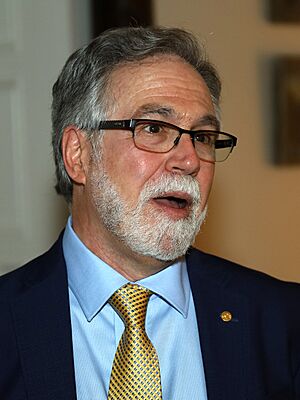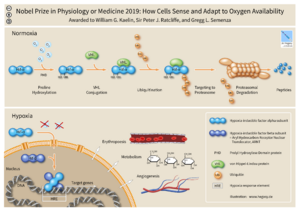Gregg L. Semenza facts for kids
Quick facts for kids
Gregg L. Semenza
|
|
|---|---|

Semenza in Stockholm, December, 2019
|
|
| Born |
Gregg Leonard Semenza
July 12, 1956 New York City, U.S.
|
| Education | Harvard University (AB) University of Pennsylvania (MD, PhD) |
| Known for | Hypoxia-inducible factors |
| Spouse(s) | Laura Kasch-Semenza |
| Awards | Albert Lasker Award for Basic Medical Research (2016) Nobel Prize in Physiology or Medicine (2019) |
| Scientific career | |
| Institutions | Johns Hopkins School of Medicine |
| Thesis | Molecular genetic analysis of the silent carrier of beta thalassemia (haplotype) (1984) |
| Doctoral advisors | Elias Schwartz Saul Surrey |
Gregg Leonard Semenza (born July 12, 1956) is an American doctor and professor of genetic medicine at the Johns Hopkins School of Medicine. He is famous for his discoveries about how the cells in our bodies sense and react to different oxygen levels.
For this groundbreaking work, he shared the 2019 Nobel Prize in Physiology or Medicine with scientists William Kaelin Jr. and Peter J. Ratcliffe. His research focused on a special protein called HIF-1, which helps cancer cells survive in low-oxygen conditions. Later in his career, some of his published research papers were withdrawn due to problems with the data.
Contents
Early Life and Education
Gregg Semenza was born in Flushing, New York City, and grew up in Westchester County, New York. In high school, he played soccer and graduated in 1974.
He went on to study medical genetics at Harvard University. For his advanced degrees at the University of Pennsylvania, he studied the genes connected to beta-thalassemia, a genetic blood disorder. After finishing his training as a children's doctor, or pediatrician, at Duke University, he became a researcher at Johns Hopkins University.
Discovering How Cells Use Oxygen
At Johns Hopkins, Dr. Semenza wanted to understand how the body deals with hypoxia, which means having low oxygen levels. Think about how you might feel out of breath after running fast or climbing a tall mountain. Your body needs a way to respond and get more oxygen.
The Role of HIF-1
Dr. Semenza studied a hormone called erythropoietin (EPO), which tells the body to make more red blood cells to carry oxygen. He discovered the key to this process: special proteins called hypoxia-inducible factors, or HIFs.
He found that a protein called HIF-1 acts like a switch. It is made of two parts:
- HIF-1β: This part is always stable and present in our cells.
- HIF-1α: This part is sensitive to oxygen. When oxygen levels are normal, this part quickly breaks down. But when oxygen is low, it becomes stable.
When HIF-1α is stable, it pairs with HIF-1β. Together, they turn on genes that help the body adapt to low oxygen, including the gene that makes more EPO. This discovery was a huge step in understanding how our bodies work at the most basic level.
Why This Research Matters
Dr. Semenza's work, along with that of his fellow Nobel winners, has been very important for medicine. Understanding the HIF-1 switch has helped scientists develop new drugs. These treatments can help patients with anaemia (a condition with too few red blood cells) and kidney failure.
The research also showed that cancer tumors can use the HIF-1 switch to build new blood vessels, which helps them grow. Scientists are now working on ways to block this process to fight cancer.
Questions About Research Papers
In science, it is very important that research results are accurate. Sometimes, a scientific journal has to retract, or withdraw, a published paper if problems are found with its data or images.
Starting in 2011, some of the research papers that Dr. Semenza co-authored were retracted. As of 2024, thirteen of his papers have been withdrawn by journals. The reason given for these retractions was the discovery of problems with images and data in the reports.
Personal Life
Dr. Semenza is married to Laura Kasch-Semenza. They met at Johns Hopkins, where she runs a facility that studies genes.
Awards
- 1989: Lucille P. Markey Scholar Award in Biomedical Science, Markey Trust
- 1995: Elected Member of the American Society for Clinical Investigation
- 2000: E. Mead Johnson Award for Research in Pediatrics, Society for Pediatric Research
- 2008: Elected Member of the National Academy of Sciences
- 2008: Elected Member of the Association of American Physicians
- 2010: Gairdner Foundation International Award
- 2012: Elected to the Institute of Medicine
- 2012: The Scientific Grand Prize of the Lefoulon-Delalande Foundation
- 2012: Stanley J. Korsmeyer Award, American Society for Clinical Investigation
- 2014: Wiley Prize
- 2016: Albert Lasker Award for Basic Medical Research (with William Kaelin and Peter J. Ratcliffe)
- 2019: Nobel Prize in Physiology or Medicine (with William Kaelin and Peter J. Ratcliffe)
See also
 In Spanish: Gregg L. Semenza para niños
In Spanish: Gregg L. Semenza para niños


